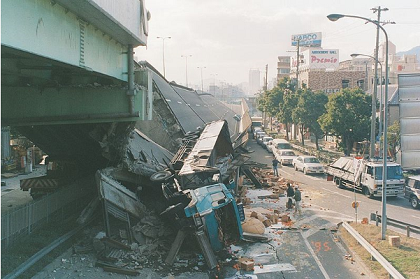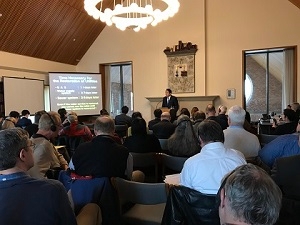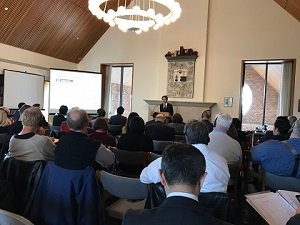Through the Eyes of the former Consul General Yamada (June, 2017 - July, 2020)
2018/3/27

The Troubles with the Toilet during a Disaster
 |
|
Hanshin Expressway after Hanshin-Awaji Earthquake in 1995
(Courtesy of Wikimedia Commons) |
When a large-scale earthquake occurs, what is the number one problem people face? Lack of food? Low water supply? Not being able to use the telephone?
Actually, the number one problem is the lack of access to a functioning toilet. When there is a power outage and water stops flowing from the tap, flush toilets (an amenity our society is used to automatically expecting,) will cease to flow as well. Humans cannot live without excretion. After a natural disaster, even while walking home, you may need to use the toilet. Yet, no matter where you are, at work, at home, even in town, there is suddenly no place with a working toilet!
With its accumulation of earthquake experiences, Japan is highly conscious of the importance of toilets. The number of families who have a “disaster toilet,” shaped like a garbage bag attached to the toilet seat, has increased. It is another matter whether such a form of disaster preparedness can be effective in an emergency. After an earthquake it can take more than one month for the sewage system to return to normal but the majority of families are unprepared for such a long-term inconvenience.
Local municipalities make temporary toilets, but they dirty quickly and only overflow with filth. While a man can hide and relieve himself safely in the shade, you can imagine that the lack of a toilet is a real problem for women. In order to decrease the frequency needed to empty the bowels, a vicious cycle forms: affected persons will decrease their food and water intake, and as a result, their physical and mental health will deteriorate. Yet, problems such as toilets and excrement tend to be absent from serious discussion on disaster preparedness, and after a disaster, society is left to deal with the same problem every time. It’s like sweeping a troublesome problem under the rug.
In Washington State, to each county and city, earthquake countermeasures are a necessary reality. On February 23rd, the Consulate-General of Japan in Seattle, Tohoku University, and University of Washington collaborated to hold a Disaster Management Symposium at the University of Washington. Over 80 locally based individuals tasked with disaster management attended. Visiting from Japan, The Hon. Hideki Matsuzaki, who served as mayor of Urayasu City – hit hard by liquefaction damage during the Great East Japan Earthquake – and Mr. Atsushi Kato, Executive Director of Japan Toilet Lab, reported with vivid detail on the lessons learned from toilet facilities in Japan and problems faced after a disaster.
 |
 |
| The Hon. Hideki Matsuzaki, former mayor of Urayasu City | Mr. Atsushi Kato, Executive Director of Japan Toilet Lab |
Five years ago when I served in Kenya, Mr. Shigeo Imai of LIXIL, who promoted a water saving toilet project, taught us that the type of toilet used for disasters could also help countries that don’t have proper infrastructure in terms of electricity, water supply, and sewage. It is said that there are currently about 2.5 billion people in the world without access to a toilet. Like in Japan during a time of disaster, women in these developing countries face great troubles. Particularly, one reason girls often do not want to go to school is because they do not want to use its toilet— a large factor in declining school enrollment rates.
In Kenya, I saw many donor countries and international organizations active in numerous development projects, but they were the Japanese organizations that cooperated towards a sustainable solution to the toilet problem. Japan is known for its toilet technology, such as the washlet. The toilet is an important topic but one on which many countries do not focus. I hope that Japan will be the one to take on this task and lead us into the future in terms of disaster countermeasures and assistance for developing countries.
